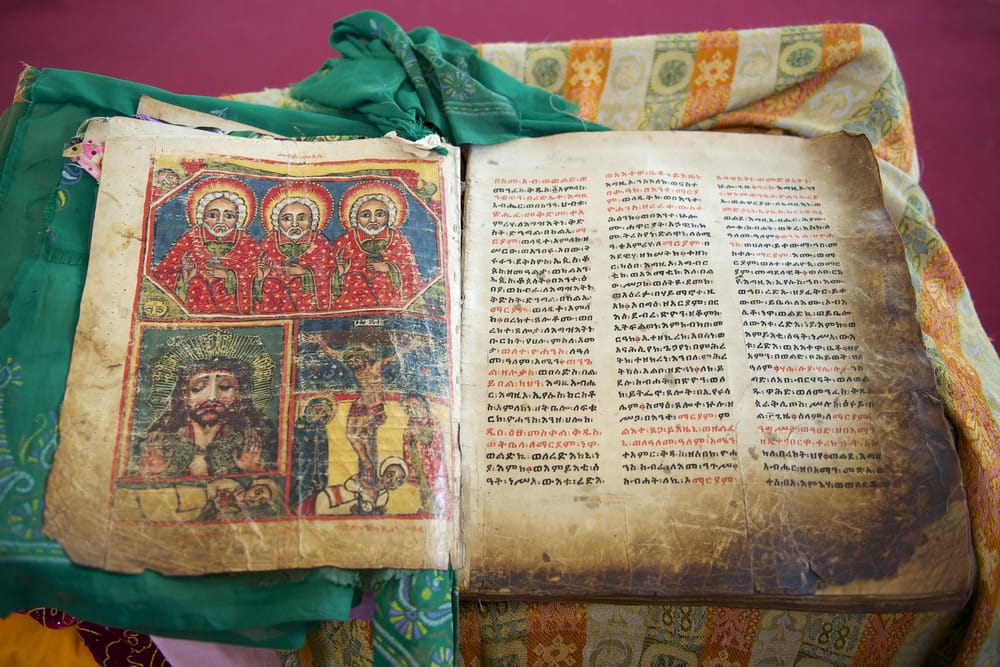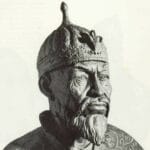Get ready for a wild ride through time as we explore the amazing world of Ezana of Axum, the legendary king who turned his kingdom into an empire and made history in the process. We’ll dig into his epic battles, his money-making secrets, and his dramatic religious adventures. So buckle up and let’s travel back to the days of ancient civilizations and uncover the mysteries of Axum and its enigmatic king, Ezana.
Mind Blowing Facts About Ezana of Axum
Ezana of Axum, now that’s a name that echoes through history! He wasn’t just another king; this guy was a total game-changer. We’re talking about the leader who took Axum from a powerful kingdom to a legendary empire. How’d he do it? Let’s dive into some mind-blowing facts about this ancient superstar:
1. Ezana’s Leap of Faith: Imagine being a king and deciding to embrace a whole new religion! That’s exactly what Ezana probably did. He was the very first Axumite ruler to likely convert to Christianity, a decision that sent ripples throughout his kingdom and beyond. This bold move made Axum one of the earliest nations on Earth to officially adopt the Christian faith. Historians suggest that this wasn’t just a personal choice for Ezana; it reshaped the religious landscape of northeastern Africa, leaving a legacy that’s still felt today.
2. The Military Mastermind: Ezana wasn’t just about faith; he knew how to command an army! He led Axum to conquer tons of territory, bringing kingdoms like Kush, Saba, and Himyar under his control. Some experts believe that if you were anywhere near Axum during Ezana’s reign, you knew his name and you probably trembled a bit when you heard it!
3. Building for the Ages: Ever heard of a king who was also a bit of an architect? Ezana was all about those magnificent buildings! During his rule, Axum was booming with incredible palaces, churches, and these massive stone pillars called stelae. These weren’t just any buildings, they were designed to show off Axum’s wealth and incredible craftsmanship. Think of them like ancient skyscrapers meant to wow anyone who laid eyes on them. And guess what? They’re still standing today, whispering stories of Ezana’s ambition and Axum’s glorious past.
4. Ezana, the Economic Wizard: A good king knows how to bring in the big bucks, and Ezana was an economic mastermind! He knew trade was key, so he made sure those trade routes were humming, bringing in goods and gold from far and wide. He also likely had a knack for agriculture, helping farmers produce more food than ever before. And get this – he even introduced a standardized currency system. Think of it like this, he created the Axumite version of dollars and cents, making trade within his empire much smoother. Talk about a forward thinker!
5. A Patron of the Arts & Culture: Now, Ezana wasn’t all about war and economics. He also knew how to appreciate the finer things in life! With Christianity as the new religion in town, Axumite art exploded with creativity. Think beautiful manuscripts, vibrant frescoes, and intricately carved stone crosses. Ezana’s embrace of Christianity didn’t just change religious practices; it may have sparked a cultural renaissance! These masterpieces weren’t just pretty to look at, they were expressions of faith and testaments to the skill of Axumite artists. And guess what? You can still see the echoes of this artistic boom in Ethiopian art and culture today.
6. The Diplomat King: Ezana understood that making friends was just as important as winning battles. He formed strong alliances with other Christian powers, especially the mighty Byzantine Empire. These weren’t just political handshakes; these partnerships opened doors for cultural exchange and even more trade, making Axum a major player on the world stage.
7. Father of the Ge’ez Script: You know how we have the alphabet? Well, Ezana might have helped bring about the Axumite version of that! Under his rule, the Ge’ez script was developed, making it possible to write down all those stories, laws, and epic poems. Imagine being the king who helped bring the written word to his people! This was a game-changer for Axum, paving the way for a more literate society and the preservation of their rich history.
8. Religious Symbolism on Coins: Ezana took his newfound faith seriously, even incorporating it into Axum’s currency. Some of the coins minted during his reign featured Christian symbols, a testament to the growing influence of the religion within the kingdom. This fusion of faith and finance provides a unique glimpse into how deeply Christianity permeated Axumite society.
9. Influence on Ethiopian Identity: Fast forward to modern-day Ethiopia, and you can still see Ezana’s fingerprints on the nation’s identity. His embrace of Christianity laid the groundwork for the Ethiopian Orthodox Tewahedo Church, a cornerstone of religious and cultural life in Ethiopia today.
10. Innovative Writing System: Beyond its religious significance, Ezana’s reign saw a major intellectual development: the rise of the Ge’ez script. This writing system, likely developed during his time, wasn’t just for religious texts; it became the tool for recording Axumite history, literature, and even everyday transactions.
So there you have it, some mind-blowing facts about Ezana of Axum. He wasn’t just a king; he was a visionary leader, a skilled warrior, a savvy economist, and a patron of the arts. He took Axum to new heights of power and left behind a legacy that continues to inspire awe and wonder. The next time you hear about ancient empires, remember Ezana, the ruler who shaped a civilization and changed the course of history.
What are some Fun Facts about Axum?
So, we’ve talked about the powerful Axumite Kingdom, but what made them so cool?
1. The Art of the Stelae: For starters, imagine a civilization known for its towering architecture. I’m talking about massive stone pillars called stelae, some stretching taller than a four-story building! The biggest one, called the Stele of Ezana, is a whopping 24 meters high and weighs more than a jumbo jet. That’s Axum for you – they thought big!
2. Masters of Metal: And their talents didn’t stop there. The Axumites were incredibly skilled metalworkers. They crafted beautiful jewelry from gold and silver, pieces so intricate they’d put modern jewelers to shame. They even minted their own coins, some imprinted with Christian symbols, a nod to their king’s conversion to Christianity centuries ago.
3. Ezana’s Conversion: Speaking of kings, let’s talk about Ezana. He wasn’t just any ruler; he was a trendsetter. When Ezana converted to Christianity in the 4th century, it was a game-changer. He wasn’t the first king to embrace Christianity, but his conversion had a ripple effect, spreading the religion throughout northeastern Africa and cementing Axum as one of the world’s earliest Christian kingdoms.
4. Trade Route Masters: Remember how I mentioned those trade routes? Well, Axum’s location on the Red Sea was like having prime real estate on a bustling ancient superhighway. They were connected to everyone – India, Arabia, the Mediterranean. We’re talking spices, silks, you name it. Some historians even suggest their trade routes might have extended as far as China and Southeast Asia! Talk about globalization, right?
5. The Ge’ez Legacy: Oh, and one last fun fact – the Axumites had their own unique writing system called Ge’ez. That’s right, they had their own alphabet! And guess what? It’s still in use today in the Ethiopian Orthodox Church. Talk about a lasting legacy!
What did King Ezana do for Aksum?
King Ezana wasn’t just another name in a long line of Aksumite rulers. He’s remembered as a powerhouse, a leader who took Aksum and basically put it on the map. Think of him like the superstar of Aksum, the one everyone remembers! So, how did he turn this kingdom into such a big deal?
1. Ezana the Conqueror: First off, Ezana was a bit of a warrior king. He wasn’t content with just the territories Aksum already had. His army was strong, and he used it to expand the kingdom’s reach, most notably by conquering the neighboring kingdom of Meroe. This was a huge victory, basically cementing Aksum as the big dog in the region.
2. Christianity’s Champion: But Ezana wasn’t all about brute force. He made a decision that totally changed the course of Aksumite history—he embraced Christianity. This wasn’t just a personal choice for him; he declared it the official religion of the entire kingdom. This wasn’t just a small change; it had ripple effects throughout Aksumite society and culture. Suddenly, they were connected to the larger Christian world, especially the Roman Empire, opening up all sorts of new possibilities for trade and diplomacy.
3. Master Builder: And if you want to see Ezana’s legacy literally carved in stone, just look at the incredible architecture from his reign. This was a period of major building projects, with massive obelisks (called stelae) shooting up into the sky and impressive buildings popping up all over the place. These weren’t just ordinary buildings, either; they were grand structures that screamed “power” and showed off just how skilled Aksumite architects and builders were. These monuments weren’t just about looking good; they were status symbols that told everyone passing through just how wealthy and influential Aksum had become.
4. Economic Genius: Speaking of wealth, Ezana was a pretty savvy businessman too. Under his leadership, Aksum’s economy thrived. He recognized the importance of trade and made sure Aksum was perfectly positioned to benefit from its strategic location along trade routes connecting the Roman Empire and India. To make things even smoother, he introduced a standardized currency, which helped trade run even more efficiently.
5. Alliance Builder: Ezana also understood that there’s strength in numbers. He wasn’t shy about forming alliances with other powerful Christian kingdoms, particularly the Byzantine Empire. This was a smart move, as it not only reduced the threat of invasion but also opened up even more opportunities for cultural exchange and cooperation. Basically, Ezana was a master networker, building relationships that would benefit Aksum for years to come.
6. Infrastructure Innovator: But Ezana’s legacy isn’t just about grand monuments and international alliances. He also understood that a strong kingdom needs a solid foundation, so he invested in infrastructure. During his reign, Aksum saw improvements in irrigation, creating a more reliable water supply for crops. He also oversaw the construction of dams and a network of roads, which made it easier to transport goods and people throughout the kingdom. These improvements might seem ordinary, but they had a huge impact on the lives of everyday Aksumites.
7. An Enigma Wrapped in History: While much is known about King Ezana’s achievements, there’s still an air of mystery surrounding some aspects of his reign. Historians are still piecing together details about his life and rule, using clues from inscriptions, stelae, and other archaeological finds.
Was King Ezana Good?
So, we’ve talked about how much King Ezana changed things in Axum. But was he actually a “good” ruler? That’s a tough question! To figure it out, we gotta look at what he did and how it affected the people of Axum, both good and bad.
1. Expansion’s Two Sides: Ezana was a total powerhouse on the battlefield. He wasn’t afraid to throw down, and he ended up conquering a bunch of territories and making Axum way bigger. Think places like Meroë and Himyar – they became part of Ezana’s empire. This obviously made Axum richer and more important in the region. But, and this is a big but, all those victories meant a lot of fighting, and probably a lot of people who weren’t too happy about being conquered. It’s tough to build an empire without breaking a few eggs, right?
2. Religious Change and Potential Conflict: One of the biggest things Ezana did was to make Christianity the official religion of Axum. This was a HUGE deal – the first Christian kingdom in all of Africa! This brought people together under one faith and changed Axum’s culture in a big way. But here’s the thing: not everyone was down with the whole Christianity thing. Some people probably liked their old gods just fine. Forcing everyone to follow the same religion might’ve caused some tension and conflict. It makes you wonder how much freedom people really had.
3. A Legacy of Grandeur: Ezana wasn’t all about war and religion, though. He was a big patron of the arts – think of him like a super-rich Medici prince, but in Africa. During his rule, Axum cranked out some seriously impressive architecture and art. We’re talking giant obelisks (they called them “stelae”) and fancy buildings that showed off just how wealthy and powerful Axum had become. Imagine walking through the capital city with all this amazing stuff around you – talk about impressive!
4. A Complex Legacy: Ezana is still remembered as a legendary king, and for good reason. He made Axum into a force to be reckoned with. He’s even considered a saint by some branches of the church! But it’s important to remember that history isn’t black and white. Ezana’s conquests came at a cost, and his religious reforms probably didn’t make everyone happy. There’s always more to the story, and that’s what makes history so fascinating!
Where does the name Ezana come from?
We’ve already talked a bit about the meaning and significance of the name Ezana, but let’s dive even deeper into its origins.
A Name Shrouded in Mystery: Although we can’t pinpoint the exact meaning of “Ezana” today – some things are lost to the sands of time – it’s clear that the name was far from ordinary. It whispered of strength, leadership, ambition, and wisdom. Imagine parents bestowing this name upon their child, almost like a prophecy for greatness.
A Name Linked to Destiny: It’s fascinating to think that names carry energy and expectations, even across millennia. And when we look at the most famous bearer of this name, King Ezana himself, we witness how powerfully a name can be interwoven with destiny. This king, who ruled the Aksumite kingdom back in the 4th century, wasn’t just any ruler. His military campaigns and impactful religious reforms left a permanent mark on the entire region.
A Legacy in a Name: So, the name “Ezana” wasn’t just a collection of sounds; it became synonymous with the might and influence of an entire kingdom. It’s almost as if the name itself, carried by this remarkable king, became a symbol of an era.
Why was Axum so powerful?
So, we’ve been talking about Axum, and you might be wondering – what made this kingdom such a big deal back in the day? Well, imagine a perfect storm of advantages coming together, and you’ve got a pretty good picture of Axum’s success story.
1. Trade Route Masters: First off, let’s talk location, location, location! Axum sat right on the Red Sea, like a shopkeeper with a prime spot on the busiest trade route in town. This wasn’t just any route – it linked Africa, Arabia, and the Mediterranean, making it a melting pot of cultures and a goldmine for anyone who controlled it. Axum used this to their advantage, trading gold, ivory, and other sought-after goods, basically becoming the ultimate middleman and raking in the wealth.
2. Agricultural Abundance: But a powerful kingdom needs more than just a good business sense, right? Axum had that covered too. Their land was fertile and perfect for growing all sorts of crops like wheat, barley, and teff – think of it as the breadbasket of the region. And don’t forget their huge herds of cattle! Back then, cattle were like walking ATMs, a sign of wealth and a source of food and stability. This combination of trade and agriculture meant Axum’s economy was booming.
3. Unified and Powerful: Of course, you don’t become a powerhouse without a bit of political savvy. Axum had some truly influential rulers who managed to unite the kingdom under their rule. They weren’t content with just one title either, adopting the impressive “Negusa Negast,” which basically means “king of kings” – talk about making a statement! With a strong leader at the helm and a powerful military, Axum expanded its reach, taking control of nearby territories in Yemen, Somalia, and even further afield.
4. Cultural Pioneers: But there’s more to Axum than just money and conquest. They were also pioneers in culture and religion. Around 350 CE, Axum converted to Christianity – a pretty big deal considering they were one of the first sub-Saharan African kingdoms to do so. This move strengthened their ties with the Christian world and ushered in a new era of cultural exchange.
5. The Gift of Ge’ez: Speaking of culture, Axum even had its own writing system called Ge’ez, which, by the way, is still used in Ethiopia today! Imagine the impact of having a written language – ideas, literature, and religious teachings could spread far and wide, cementing Axum’s reputation as a center of learning and innovation.
6. Cattle: More than Meets the Eye: Now, historians are always digging deeper, trying to piece together the full picture of Axum’s success. Some believe their unique cattle-based society played a huge role in shaping their social hierarchy and political power. After all, the more cows you had, the more important you were!
7. Masters of Diplomacy: Another fascinating aspect is Axum’s diplomatic relationships. They weren’t afraid to reach out and make friends in high places, forging alliances with powerful empires like Byzantium. These relationships weren’t just for show – they fostered cultural and economic exchange, further enriching Axum’s already vibrant society.
8. Geography’s Role: And let’s not forget the role of good old-fashioned geography. Axum was blessed with a location that received plenty of rainfall, ensuring their crops flourished and their economy thrived. It’s amazing how something as simple as rain can shape the destiny of an entire kingdom, isn’t it?
9. An Unfolding Story: Keep in mind, our understanding of Axum is constantly evolving as archaeologists and historians uncover new evidence. What we know today is just a glimpse into their complex story, and who knows what other secrets of this once-great kingdom are waiting to be unearthed?
What Made Axum Wealthy?
So, we’ve talked about Axum’s rise to power, but what really fueled its economy and made it such a prosperous kingdom? Well, it seems like a few key ingredients came together to create the perfect recipe for wealth in Axum.
1. Agricultural Bounty: First off, imagine a land blessed with fertile soil and predictable rainfall. That was Axum! Thanks to the summer monsoon rains, their farmlands consistently produced a bounty of crops like wheat, barley, millet, and teff. This abundance did more than just feed the people; it gave them surplus goods to trade with others.
2. Strategic Trade Positioning: Then, there’s Axum’s strategic location. You see, they sat right on major trade routes, kind of like how a busy highway rest stop attracts tons of travelers. This gave them a huge advantage, especially when it came to controlling the flow of valuable ivory from Sudan.
3. Maritime Masters: And it wasn’t just about controlling existing trade routes; Axum went the extra mile and built a powerful maritime network. This allowed them to connect with far-off lands like India and Southeast Asia, opening up exciting new markets and trade possibilities. They were exchanging goods like textiles, spices, and incense, bringing valuable commodities back to Axum and adding to their coffers.
4. Natural Resources: Let’s not forget about the natural resources! Axum was blessed with deposits of gold, iron, and salt – things that everyone, everywhere always seems to need. This attracted merchants from far and wide, eager to get their hands on these valuable materials. It’s like having a giant “Open for Business” sign painted on your front door, but even more enticing.
5. The Christianity Factor: Then, in the 4th century CE, something interesting happened: Axum embraced Christianity. Now, this wasn’t just a major religious shift; it had economic ripples, too. Beautiful churches were built, drawing pilgrims and travelers to the kingdom, further boosting the economy. Plus, the spread of Christianity fostered connections with other powerful Christian empires, leading to even more trade opportunities and cultural exchange.
6. A Recipe for Success: So, while we might not have all the answers about Axum’s success story, evidence suggests that its wealth was a combination of factors: bountiful agriculture, clever trade strategies, desirable natural resources, and a dash of religious influence. They were savvy, resourceful, and definitely knew how to capitalize on their strengths. It’s a story that reminds us how interconnected factors, from geography to religion, can shape a nation’s destiny.
How Old is Axum?
We’ve already touched on how impressive Axum was as a kingdom, but let’s dive a little deeper into the mystery of its age. Pinpointing the exact moment Axum transformed from a settlement into a mighty civilization isn’t as straightforward as you might think.
A Gradual Rise: Most historians and archaeologists, after carefully studying the evidence we have, lean towards the idea that Axum really started flexing its muscles as a powerful force around the 1st century CE. This lines up with what’s been unearthed at archaeological sites and fits with the timeline suggested by ancient texts.
Early Beginnings? However, it’s important to remember that the story of Axum, like many ancient civilizations, is still being pieced together. New discoveries are always being made that have the potential to shift our understanding. Some scholars believe that Axum’s roots might actually stretch back even further, perhaps originating several centuries before the common era. They point to intriguing clues like ancient burial mounds and artifacts that suggest a more complex and longer history than we currently grasp.
An Enduring Legacy: This ongoing exploration is what makes studying Axum so fascinating! While the exact date of its “birth” might still be a bit hazy, one thing is undeniable: Axum enjoyed a long and impactful reign. Its influence stretched over centuries, leaving a mark that we can still appreciate today through its awe-inspiring ruins and the echoes of its culture.
What is the city of Axum known for?
Axum, tucked away in the Ethiopian highlands, is a city brimming with history. It’s not just any history, though, it’s the type that makes you think, “Wow, if these walls could talk…”. As the former heart of the Aksumite Empire, Axum’s influence stretched far and wide, and its legacy continues to fascinate historians and travelers alike.
1. Stelae City: Let’s talk about those incredible stelae for a second. Imagine towering obelisks, some reaching the height of a 10-story building, carved from single blocks of granite. These aren’t just random pillars; they’re intricately engraved with stories, chronicles of kings and queens, and symbols that researchers are still trying to fully decipher. They’re like giant stone books, a testament to the engineering and artistic skills of the Aksumites.
2. Cradle of Christianity: But Axum’s story isn’t just etched in stone; it’s woven into the fabric of Christianity itself. Many believe it was one of the first places where Christianity truly flourished, even predating some of the major European Christian centers. The city is home to ancient churches, places of deep religious significance, none more famous than the Church of Our Lady Mary of Zion. Legend has it that this very church safeguards the Ark of the Covenant, the sacred chest containing the Ten Commandments. While the existence of the Ark within the church is debated, the possibility alone draws pilgrims and curious minds from all corners of the globe.
3. Ancient Metropolis: And Axum wasn’t just a spiritual center; it was a bustling metropolis. Imagine a crossroads where merchants from across continents converged, trading spices, textiles, and precious metals. This was Axum in its heyday, strategically positioned on ancient trade routes, its coffers overflowing thanks to its prime location and fertile land.
4. Unraveling the Past: This is just a glimpse of what Axum offers. Every corner you turn, you’re likely to stumble upon ruins whispering tales of a glorious past. Ongoing archaeological digs continually unearth new artifacts, constantly adding to the narrative of this ancient city. So, while we’ve covered the basics, the reality is that Axum’s full story is still being pieced together, making it all the more intriguing.
Did Axum have coins?
So, we’ve been talking about the Kingdom of Axum, right? This powerful empire in ancient Africa had a lot going for it, but did they have their own money? You bet they did! And it’s a bigger deal than you might think.
1. Minting a Legacy: See, Axum was the very first south of the Sahara to mint its own coins. That’s huge! Before that, kingdoms across Africa relied on bartering, trading goods for other goods. Or, they’d use foreign currency, which isn’t exactly ideal if you want to be seen as a major power. By creating their own coins, Axum showed the world they were economically savvy and ready to play on a global stage.
2. Coins as Calling Cards: And play they did! Axumite coins haven’t just been found in Ethiopia. Nope, these little pieces of history have turned up in archaeological digs all the way from India to Sri Lanka. That tells us Axumite merchants weren’t just hanging around at home – they were sailing the high seas, making deals across the Indian Ocean, and building a vast trading network that stretched for thousands of miles.
3. Windows to the Past: But these coins aren’t just proof of economic prowess. They’re like little windows into the cultural heart of Axum. Some coins have Greek inscriptions, hinting at Axum’s friendly relationship with the Roman Empire. Others have symbols from the Sabaean religion, showing how the South Arabian kingdom of Saba influenced Axum’s beliefs and customs. Basically, by studying the coins, we get a glimpse into the fascinating blend of cultures that made Axum so unique.
4. Unlocking the Secrets: Now, while we know Axum minted coins, there’s still so much we’re learning. Researchers are hard at work, studying the coins, trying to decipher the inscriptions, and piece together the full story of Axum’s monetary system.
How tall is Axum in Ethiopia?
Now, when we talk about “Axum’s height,” we’re probably thinking about the star of the show – the main Obelisk of Axum. This thing is a giant! It stretches a whopping 24 meters (79 feet) into the sky, which is roughly the height of a six-story building. Can you imagine the effort it took to build something that massive almost 1,700 years ago?
1. A Towering Feat: And it’s not just tall, it’s heavy too! We’re talking 160 tons of solid granite, all carved from a single piece of stone. This tells you a lot about the Aksumite Empire and their crazy engineering skills. They didn’t have modern cranes and trucks back then, so they had to rely on ingenuity and manpower.
2. Stories in Stone: This Obelisk isn’t just a pretty face either. It’s covered in intricate carvings that tell stories about the Aksumite people, their battles, and their beliefs. The base, for example, depicts scenes from the Battle of Adulis, a pivotal moment in their history. And if you look closely at the upper part, you can see inscriptions in the ancient Ge’ez script, which scholars are still trying to fully decipher. It’s like a giant stone book, just waiting to be read!
3. A Symbol of Resilience: Speaking of stories, this Obelisk has seen a lot in its time. It was originally erected way back in the 4th century CE during the reign of King Ezana, a name that still echoes through Ethiopian history. It stood tall for centuries, witnessing the rise and fall of empires, until it was sadly toppled by Italian forces in 1937. They took it to Rome as a spoil of war, but thankfully, after years of diplomatic efforts, the Obelisk was finally returned to its rightful home in Ethiopia in 2005. It was a moment of national celebration when they finally re-erected it in 2008.
4. A Legacy Remembered: Today, the Obelisk of Axum stands tall once again, a powerful symbol of Ethiopian resilience and a testament to the enduring legacy of the Aksumite civilization. No wonder UNESCO declared it a World Heritage Site! This ancient monolith attracts visitors from all corners of the globe, who come to marvel at its sheer size, intricate details, and the fascinating history it represents. It’s a stark reminder of the ingenuity of our ancestors and the enduring power of human civilization.
- Unveiling the Enigma: Mansoureh Khojasteh Bagherzadeh’s Public Appearances & Private Life in Iran - July 18, 2025
- Unveiling the Mystery: Mansoureh Khojasteh Bagherzadeh’s Husband: A Rare Glimpse into a Private Life - July 18, 2025
- Unveiling Masoud Khamenei’s Mother: Power, Influence, and Iran’s Future - July 18, 2025

















2 thoughts on “Unearth the Mind-Blowing Facts About Ezana of Axum”
Comments are closed.